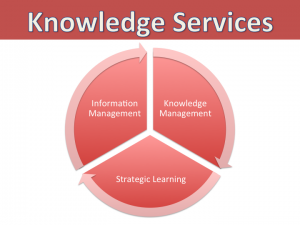“What’s this knowledge services you talk about so much, Guy?”
Yes, it a question I get a lot, and true to form, I was recently asked about how I got involved in knowledge services.
As most people who know me can attest, I’m always happy to supply a little history about knowledge services. And as we begin the new academic year, why not? Now that SMR International is into the 16th year since we introduced the concept (at least we think we did – we hadn’t heard anything about knowledge services until we started talking about it), it just makes sense to give some attention to how knowledge services came about.
Here’s my version:
 We understand now that it is through the convergence of information management, knowledge management, and strategic learning that we create knowledge services, the underlying foundation for the knowledge culture. Naturally we’re asked: cannot knowledge management (KM) do the job? Why must KM converge with information management and strategic learning to support enterprise success?
We understand now that it is through the convergence of information management, knowledge management, and strategic learning that we create knowledge services, the underlying foundation for the knowledge culture. Naturally we’re asked: cannot knowledge management (KM) do the job? Why must KM converge with information management and strategic learning to support enterprise success?
There are two reasons. The first is that in today’s business and research environment, the management of information, knowledge, and strategic learning as unconnected activities (even when these activities are recognized as related) is insufficient. The problem has to do with the standard “silo” or “stovepipe” issues we hear so much about. For several years, leaders in the three disciplines (and, we’re discovering, in other disciplines as well) have been doing a good job of establishing their credentials and proving the viability of providing an organizational focus in their particular area of expertise. But they were working alone, or each in their own performance environment. Information management, knowledge management, and strategic learning – as organizational functions – were not working together.
With these three lines of work, we’ve now for several decades been able to see the engineers and technical professionals making great progress in resolving the issues connected with managing information (with no small assistance from many, many intellectual leaders in other disciplines, it must be noted). KM, too, when it came into the picture as intellectual capital, created its own body of practitioners although, as we’ve thought about often, it was at times a confused and amorphous coterie of people doing their best to bring some level of order out of the KM chaos. Similarly and throughout many professions, the development and provision of strategic learning as an operational function was given attention, and very successful tools and techniques for managing strategic learning were created and implemented.
But these efforts were not enough. Why? Because organizational managers, corporate executives, and even leaders in organizations and institutions that were not necessarily business focused demanded a unified approach. They needed an enterprise-wide knowledge strategy that enabled the sharing of all strategic knowledge, a strategy that would enable the enterprise to access and deliver any content connecting to any part of the organization and, not to be dismissed, to organizational success. They wanted to see a practical approach to managing knowledge.
And since they could not—quite understandably—grasp the idea of managing knowledge, they had to be given something they could understand, a practical approach to servicing the knowledge-sharing needs of their employees, partners, affiliates, and anyone else with a reasonable connection to their organization’s effectiveness.
One thing executives did understand was the concept of services, enterprise support activities that are part of the organization and incorporated into the organizational financial framework. These services are included in the organizational management function or contracted for and paid for, all as part of doing business. So it made sense for them to respond to the idea of services in support of knowledge sharing. Since they understood the purpose and function of legal services, say, or accounting services or HR services or facilities-maintenance services, they could understand the purpose and function of knowledge-sharing services.
At the same time, management leaders in organizations and corporations began to recognize that knowledge sharing cannot take place within discreet functional entities, thus providing us with the second reason why KM alone cannot do the job. With the build-up of those many separate and distinctive disciplines for handling knowledge content over the years—along with the concomitant growth of academic or academic-type education and training in support of those disciplines—the organization became flooded with functional units that were theoretically supposed to be about knowledge capture and knowledge sharing.
In reality, exactly the opposite happened. With functional units such as records management departments, specialized libraries, corporate or organizational archives, staff training and learning units, even information technology departments being created and put into place as separate operational entities, no one was looking after enterprise-wide knowledge development and knowledge sharing. There was a need for an institution-wide knowledge culture, one that would engage not only the usual information-focused units of the organization, but all functional units as well, including such critical administrative operations as executive services, financial management, HR, research and development, marketing, sales, legal services, and, yes, even facilities management. They all needed a practical way to develop and share knowledge for the benefit of the organization that employed them, and knowledge services appeared on the scene to meet their needs. By converging information management, knowledge management, and strategic learning as an enterprise-wide management methodology, knowledge services enables knowledge sharing among all knowledge-related activities.

Leave a Reply